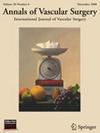“过氧化物酶体增殖物激活受体(PPARs)在腹腔动脉瘤患者离体动脉组织中的表达及其与壁重塑和炎症基因表达的关系”。
IF 1.6
4区 医学
Q3 PERIPHERAL VASCULAR DISEASE
引用次数: 0
摘要
背景:腹主动脉瘤(AAA)的发病是多因素的,具有复杂的病理生理过程,包括细胞因子分泌和蛋白酶介导的血管细胞外基质(ECM)降解。过氧化物酶体增殖物激活受体(PPARs)是一类调节代谢酶和细胞因子基因表达的核受体。然而,ppar对血管生理的分子机制尚未得到充分的评价。我们的目的是评估离体主动脉组织中ppar的表达与动脉重塑和炎症标志物的基因表达之间的关系。方法:选取20例(平均年龄69岁,标准差(SD) 5)行开放式AAA修补术的患者的两份主动脉组织样本。一个来自动脉瘤囊,另一个来自未患病的邻近主动脉组织。采用苏木精和伊红、马松三色和范吉森染色对福尔马林固定和石蜡包埋的4微米(μm)切片进行组织病理学评估和动脉壁厚度形态测定。提取总核糖核酸(RNA)并进行反转录,利用特异性正向和反向寡核苷酸和SybrGreen主混合物,通过实时聚合酶链反应(PCR)检测ppar、基质重塑蛋白和细胞因子基因表达。采用Prism 8 for Mac (GraphPad, San Diego, CA, USA)的非参数Mann-Whitney U检验进行统计分析。结果:动脉瘤活检显示平滑肌细胞丢失,弹性纤维碎片化和紊乱,细胞外基质成分改变。与来自相同患者的未患病对照组织相比,动脉瘤主动脉中PPARα, PPARδ和PPARγ的表达显著降低(分别为59%,61%和42%)。结论:这些结果证实了ppar基因表达与炎症细胞因子mRNA水平呈负相关,以及不利的动脉重塑基因表达。主动脉组织中三种PPAR亚型表达的减少似乎会促进动脉异常重塑和促炎细胞因子的产生,从而导致动脉壁变薄和AAA进展。本文章由计算机程序翻译,如有差异,请以英文原文为准。
Expression of the Peroxisome Proliferators–Activated Receptors in Ex Vivo Arterial Tissue of Patients with Abdominal Aortic Aneurysms and Its Association With Wall Remodeling and Inflammatory Gene Expression
Background
The pathogenesis of abdominal aortic aneurysms (AAAs) is multifactorial, characterized by complex pathophysiological processes, including cytokine secretion and protease-mediated degradation of the arterial extracellular matrix (ECM). Peroxisome proliferators–activated receptors (PPARs) are a group of nuclear receptors that regulate the expression of genes for metabolic enzymes and cytokines. However, the molecular mechanisms of PPARs on vascular physiology are not fully evaluated. Our objective was to assess the association between the expression of PPARs in ex vivo aortic tissue and the gene expression of markers of arterial remodeling and inflammation.
Methods
Two aortic tissue samples were obtained from 20 patients (mean age 69 years, standard deviation 5) who underwent open AAA repair. One from the aneurysmal sac and other from the nondiseased adjacent aortic tissue. Four micrometers sections of formalin-fixed and paraffin embedded samples were stained with hematoxylin and eosin, Masson's trichrome and Verhoeff-van Gieson for histopathologic evaluation and arterial wall thickness morphometry. Total RNA was extracted and retrotranscribed to determine PPARs, matrix remodeling proteins, and cytokine gene expression by real-time polymerase chain reaction using specific forward and reverse oligonucleotides and SybrGreen master mix. Statistical analysis was conducted using the nonparametric Mann–Whitney U-test in Prism 8 for Mac (GraphPad, San Diego, CA, USA).
Results
Aneurysm biopsies demonstrated loss of smooth muscle cells, and fragmented and disorganized elastic fibers and changes in ECM composition. The expression of PPARα, PPARδ, and PPARγ was significantly lower in the aneurysmal aorta compared to the nondiseased control tissue from the same patients (59%, 61%, and 42%, respectively, P < 0.01). The expression of the matrix metalloproteinase inhibitor tissue inhibitor of metalloproteinase 4 was significantly reduced in the aneurysmal tissue compared to control (64%), whereas that of the vascular ECM–degrading enzyme cathepsin S was 7-fold higher in the aneurysmal aortic tissue (P < 0.01). Gene expression of monocyte chemoattractant protein-1 and the cytokines tumor necrosis factor α and interleukin-1β was significantly upregulated in the aneurysmal tissue compared to the control nondiseased tissue (20-fold, 83-fold, and 18-fold, respectively, P < 0.001).
Conclusion
These results confirm an inverse correlation between PPARs gene expression and inflammatory cytokine mRNA levels, along with an unfavorable arterial remodeling gene expression. The decrease in the expression of the three PPAR isoforms in the aortic tissue appears to promote abnormal arterial remodeling and the production of proinflammatory cytokines leading to wall thinning and AAA progression.
求助全文
通过发布文献求助,成功后即可免费获取论文全文。
去求助
来源期刊
CiteScore
3.00
自引率
13.30%
发文量
603
审稿时长
50 days
期刊介绍:
Annals of Vascular Surgery, published eight times a year, invites original manuscripts reporting clinical and experimental work in vascular surgery for peer review. Articles may be submitted for the following sections of the journal:
Clinical Research (reports of clinical series, new drug or medical device trials)
Basic Science Research (new investigations, experimental work)
Case Reports (reports on a limited series of patients)
General Reviews (scholarly review of the existing literature on a relevant topic)
Developments in Endovascular and Endoscopic Surgery
Selected Techniques (technical maneuvers)
Historical Notes (interesting vignettes from the early days of vascular surgery)
Editorials/Correspondence

 求助内容:
求助内容: 应助结果提醒方式:
应助结果提醒方式:


